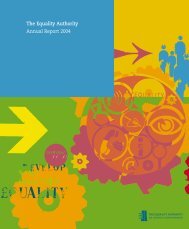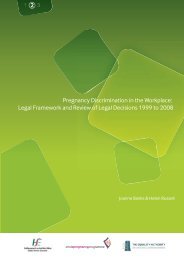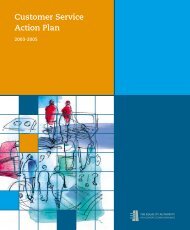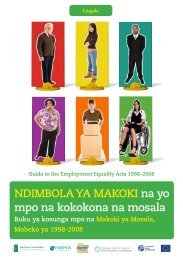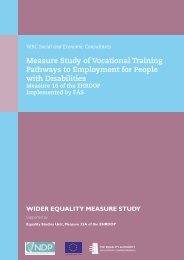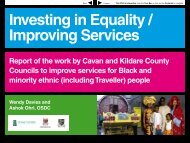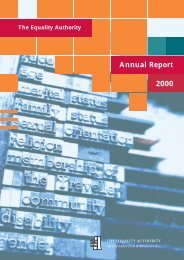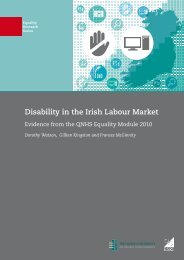Pregnancy and Employment: A Literature Review - Crisis Pregnancy ...
Pregnancy and Employment: A Literature Review - Crisis Pregnancy ...
Pregnancy and Employment: A Literature Review - Crisis Pregnancy ...
Create successful ePaper yourself
Turn your PDF publications into a flip-book with our unique Google optimized e-Paper software.
<strong>Pregnancy</strong> <strong>and</strong> <strong>Employment</strong>: A <strong>Literature</strong> <strong>Review</strong><br />
young children can return to employment at all (e.g. Stier et al, 2001; Gornick et al, 1997, Gornick, 2008; Esping-<br />
Andersen 1999). These policy factors are the focus of Section 3.6. Finally Section 3.7 looks at cohort effects -<br />
change over time net of changes in other characteristics.<br />
3.2 Human Capital<br />
Women with higher educational qualifications <strong>and</strong> those who occupy privileged job positions prior to childbirth<br />
are likely to have both stronger financial incentives <strong>and</strong> non-financial motives for returning to employment<br />
than those with few qualifications <strong>and</strong>/or low-skilled jobs. High-skilled women can comm<strong>and</strong> higher wages; in<br />
economic terms, the opportunity costs of staying outside the labour market are therefore higher. Moreover,<br />
women with a higher earning capacity are in a better financial position to afford childcare (when this cost is not<br />
borne by the State) <strong>and</strong> to outsource other domestic tasks. It has also been argued that the costs of taking a break<br />
in employment in terms of career development may be greater for those in professional/managerial positions than<br />
for those lower down the occupational hierarchy (Smeaton, 2006).<br />
Education <strong>and</strong> occupational level are also likely to correlate with other important non-financial elements of work<br />
experience. Those with higher educational qualifications or occupying professional/managerial positions also tend<br />
to enjoy greater intrinsic rewards, such as a greater degree of autonomy <strong>and</strong> more opportunity to exercise their<br />
skills. This is exemplified by higher levels of job satisfaction <strong>and</strong> organisational commitment among these groups<br />
(O’Connell et al, 2004).<br />
In the economic literature, previous job experience is also used as a key indicator of human capital <strong>and</strong> is found<br />
to be associated with pay levels. In the case of women who have recently had children, prior work experience is<br />
also likely to capture commitment to employment, while longer job tenure indicates greater commitment to the<br />
previous job. Higher levels of job-specific human capital (such as years of accumulated experience, job-specific<br />
training, specialised education) also make it more difficult for the employer to replace the employee; employers<br />
are also likely to invest more effort in retaining such women following childbirth.<br />
Therefore, in general, there is an expectation that higher levels of human capital will make a return to work more<br />
likely following childbirth, <strong>and</strong> sooner rather than later. However, there are pressures that may pull in the opposite<br />
direction. Most notably, women in unskilled occupations may be under greater financial pressure to return to<br />
employment relatively soon after they have given birth, while those in higher-level occupations will have the<br />
resources to sustain a longer period of leave. This countervailing influence is recognised by Smeaton (2006, p13)<br />
when she points out that:<br />
“The inverse scenario applies to women lower down the occupational hierarchy for whom career disruption may<br />
have fewer long term consequences, but the sacrifice of salary may not be sustainable.”<br />
At least one of these variables (education, occupation, work experience) is included in all the empirical studies of<br />
women’s return to work following childbirth, discussed below. In some cases all three are tested. In some of the<br />
studies the effects of earnings prior to birth are also tested directly.<br />
The only previous research examining Irish women’s transitions back to employment after childbirth using<br />
longitudinal data is contained in a cross-national study by Russell et al (2006), which compares return to<br />
employment among women in Irel<strong>and</strong>, the UK, Germany <strong>and</strong> Sweden. The Irish results were based on analysis of<br />
eight waves of the Living in Irel<strong>and</strong> Panel Survey. The survey began in 1994 <strong>and</strong> respondents were re-interviewed<br />
each year up to 2001. The surveys were conducted at approximately one-year intervals <strong>and</strong> any births between the<br />
waves were recorded. 24 The first element of the analyses was to investigate the factors that influenced being back<br />
in employment at the first interview after the birth. As the births were distributed across the year, the age of the<br />
child of the interviewee could vary between zero <strong>and</strong> around 12 months. The Irish results show that women with<br />
third-level qualifications were significantly more likely to be back in employment at the first interview post-birth, as<br />
24 The German sample came from the German Socio-Economic Panel. The UK analysis used the British Household Panel Survey, <strong>and</strong> the Swedish<br />
analysis was based on ULF panel surveys (the Statistics Sweden Survey of Living Conditions). The German <strong>and</strong> British panels were run annually<br />
but over a much longer period than the Irish survey, thus providing a greater number of cases for analysis. The Swedish panel were only reinterviewed<br />
after a seven-year interval.<br />
PAGE 27




